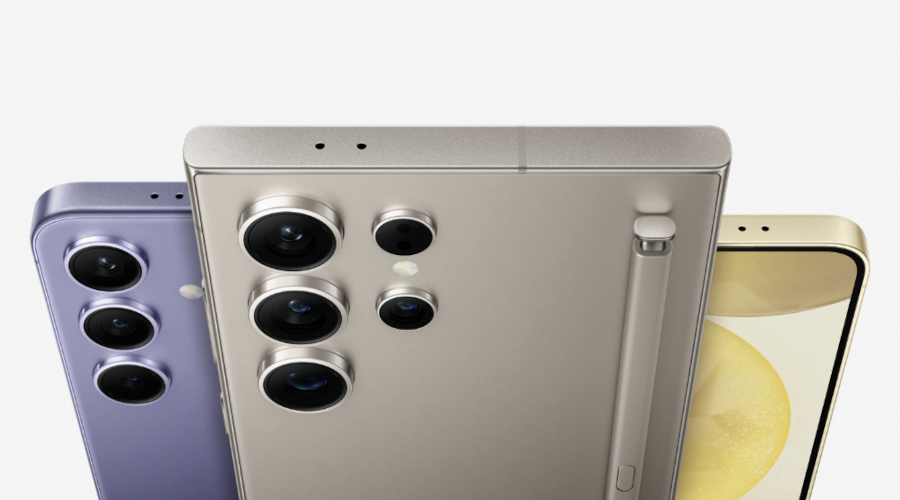 APPS
APPS
 APPS
APPS
 APPS
APPS
Samsung Electronics Co. Ltd. today debuted its new flagship smartphone lineup, the Galaxy S24 series, which features artificial intelligence software from Google LLC and Qualcomm Inc.’s fastest mobile chip.
The handset family is headlined by the Galaxy S24 Ultra, a 6.8-inch flagship that will sell for $1,300. It’s joined by the 6.2-inch Galaxy S24 and 6.7-inch Galaxy S24 Plus. The two devices will retail for $800 and $1,000, respectively.
All three smartphones in the S24 series feature a set of generative AI features powered by technology from Google. The first set of capabilities, which will automate tasks such as text summarization, runs on the search giant’s Gemini line of large language models. Users will also have access to photo editing features powered by Google’s Imagen 2 neural network.
The S24 Ultra runs the Gemini models locally on its processor, the Qualcomm-developed Snapdragon 8 Gen 3 system-on-chip. The U.S. editions of the S24 and S24 Plus use the same chip. The latter devices’ international versions, in turn, will ship with a SoC from Samsung’s own Exynos processor lineup.
Qualcomm’s Snapdragon 8 Gen 3 features a subsystem called the AI Engine that is optimized to run neural networks. According to the chipmaker, it’s capable of running models with up to 10 billion parameters. The subsystem is powered by two separate compute modules that each focus on a different set of AI use cases.
The first module is the Snapdragon 8 Gen 3’s Hexagon neural processing unit, or NPU. Qualcomm says that the accelerator is 98% faster than its previous-generation NPU. The AI Hub also includes a second accelerator, Sensor Hub, that features two cores geared towards use cases such as running chatbots.
Qualcomm has combined its AI-optimized silicon with a software capability called Micro Tile Inferencing. It will allow Samsung’s new smartphones to split up a neural network into up to tens of thousands of smaller chunks dubbed tiles. From there, the Snapdragon 8 Gen 3 can run many of those tiles in parallel, which is faster than the usual approach of running them one after one another.
The chip’s AI modules are supported by an integrated central processing unit. It features three different types of cores with varying maximum clock speeds. S24 devices can run apps that require limited computing resources on the slowest cores, which consume relatively little power, and thereby achieve a longer battery life.
The improved silicon is not the only highlight of the S24 series. Samsung has also made a number of other hardware upgrades spanning the case, display and cameras.
The flagship S24 Ultra swaps its predecessor’s aluminum case for one made of titanium, a more durable metal. Samsung has kept last year’s 6.8-inch, 1440p screen, but in a more rectangular form factor that lacks curved edges. The company kept the rear camera array mostly unchanged as well with the exception of the zoom lens, which has been upgraded from 10 megapixels to 50.
In the S24 and S24 Plus, the most significant upgrades were made to the devices’ displays. They’re one tenth of an inch bigger than the screens in last year’s models and more than 50% brighter. The S24 Plus has the same 1440p resolution as the flagship S24 Ultra, up from 1080p last year.
Alongside the S24 lineup, Samsung today previewed an upcoming wearable dubbed the Galaxy Ring. It’s a smart ring that the company describes as a “health and wellness device.” Samsung also detailed that users will have access to built-in AI capabilities, but didn’t elaborate on the gadget’s feature set, pricing or availability date.
The Galaxy Ring will create more competition in the already crowded AI-powered wearables segment. In November, startup Humane introduced a $700 pin that provides access to OpenAI’s GPT-4. A few weeks earlier, Meta Platforms Inc. debuted a version of its Ray-Ban smart glasses with a built-in AI assistant.
Samsung already competes in the wearables market with several products including its Galaxy Watch product series, which was most recently refreshed last July. The smartwatch line provides integrations that allow users to access notifications from a linked Galaxy S handset and perform related tasks. It’s possible that the Galaxy Ring will also integrate with Samsung’s flagship smartphones.
Support our mission to keep content open and free by engaging with theCUBE community. Join theCUBE’s Alumni Trust Network, where technology leaders connect, share intelligence and create opportunities.
Founded by tech visionaries John Furrier and Dave Vellante, SiliconANGLE Media has built a dynamic ecosystem of industry-leading digital media brands that reach 15+ million elite tech professionals. Our new proprietary theCUBE AI Video Cloud is breaking ground in audience interaction, leveraging theCUBEai.com neural network to help technology companies make data-driven decisions and stay at the forefront of industry conversations.